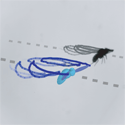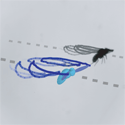Fruit flies swim through air
The fruit fly buzzing around your fruit bowl may be doing the butterfly stroke. A new experiment reported in Physical Review Letters shows that—contrary to popular wisdom—paddling can be as effective in air as it is in water. This could imply that insects evolved their flight capability from some earlier swimming trait.
Flying is typically associated with the force of lift that results from the pressure difference above and below a wing. Birds and other fliers generate lift during a flap by tilting their wings so as to slice through the air. Although some swimmers also use lift to move through water, the more common force is drag. Drag is the resistance from the surrounding fluid, but it can also be used for propulsion, as when the swimmer Michael Phelps “pulls” water with his cupped hands.
Drag-based paddling was thought to be confined to swimming, but recently it was observed in the hovering of dragonflies. Leif Ristroph of Cornell University and his colleagues wanted to test whether drag could also produce forward flight. Their chosen subject was the common fruit fly (Drosophila melanogaster). Using high-speed video cameras to track wing motion, the team observed certain cases where the flies paddled their wings forward and backward. To confirm that this was indeed drag-based motion, the team plugged their wing data into an “insect flight simulator” and found that they could reproduce the fly’s overall movement. The authors constructed a simple model of paddling, which seems to support the theory that insect wings evolved in water. – Michael Schirber





